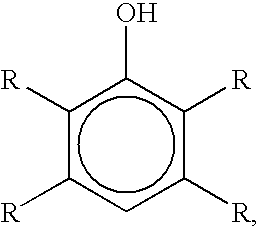Method for preparation of para-brominated hydroxyaromatic compounds
a technology of hydroxyaromatic compounds and brominating reagents, which is applied in the direction of physical/chemical process catalysts, other chemical processes, separation processes, etc., can solve the problems of reducing the synthesis efficiency of p-bromophenol by reducing the synthesis efficiency of p-bromophenol, observing loss of organic substrates, and no set of reaction conditions to date to achieve 100% selective reaction to desired p-bromophenol isomer,
- Summary
- Abstract
- Description
- Claims
- Application Information
AI Technical Summary
Benefits of technology
Problems solved by technology
Method used
Image
Examples
example 1
Bromination of Phenol-Two Phase
[0050]To a Parr autoclave reactor fitted with a glass liner was charged phenol (61.07 g, 650 mmol, 1 eq.), 48% HBr (81.08 g, 480 mmol, 0.74 eq.) and CuBr2 (3.6 g, 1.6 mmol, 0.0025 eq.). The mixture was heated at 65° C. under 34 atm of air for 30 minutes. The resulting two-phase mixture was separated using a separatory funnel, and each phase was analyzed using standard GC techniques. The total mixture was found to contain the following: phenol (41.1 g, 437.10 mmol, 49.91 wt. %); 4-bromophenol (29.8 g, 172.00 mmol, 35.73 wt. %) and 2-bromophenol (5.1 g, 29.67 mmol, 6.17 wt. %), corresponding to 32.6% conversion of phenol with 81.2% selectivity for 4-bromophenol, a total monobromophenol selectivity of 95.2%, and a total phenolic mass balance of 98.4%. No analysis was done for copper, but see Example 5. The HBr conversion to bromophenols was 42%. After separating the organic phase from the aqueous phase, the organic phase was found to contain ˜97% of the o...
example 2
[0051]The organic phase (83.56 g) from Example 1 is washed with water (10 g) to remove traces of Cu and HBr, and the wash aqueous phase (about 10 g) is separated from the washed organic phase (about 83 g). The aqueous wash phase (about 10 g) is combined with aqueous phase from Example 1 containing the bulk of the catalyst (about 62.68 g).
example 3
Separation of Brominated Products and Isomerization
[0052]The organic phase from Example 2 is distilled into a low-boiling fraction (about 49 g), containing the majority (>98%) of the water and phenol present, and also containing traces of brominated compounds, a medium-boiling fraction (about 8 g) containing >98% of the 2-bromophenol and <10% of the 4-bromophenol, and a high-boiling fraction (about 26 g), containing primarily 4-bromophenol, which exits the process. The medium-boiling fraction is isomerized by adding aqueous HBr (about 2 g of aqueous HBr, 48%) and phenol (about 15 g), and heating the resulting pre-equilibrium mixture to 150° C. for 20 minutes. The isomerization results in a post equilibration mixture where the ratio of 2-bromophenol to 4-bromophenol is about 1:1.
PUM
| Property | Measurement | Unit |
|---|---|---|
| temperature | aaaaa | aaaaa |
| pressure | aaaaa | aaaaa |
| boiling point | aaaaa | aaaaa |
Abstract
Description
Claims
Application Information
 Login to View More
Login to View More - R&D
- Intellectual Property
- Life Sciences
- Materials
- Tech Scout
- Unparalleled Data Quality
- Higher Quality Content
- 60% Fewer Hallucinations
Browse by: Latest US Patents, China's latest patents, Technical Efficacy Thesaurus, Application Domain, Technology Topic, Popular Technical Reports.
© 2025 PatSnap. All rights reserved.Legal|Privacy policy|Modern Slavery Act Transparency Statement|Sitemap|About US| Contact US: help@patsnap.com

